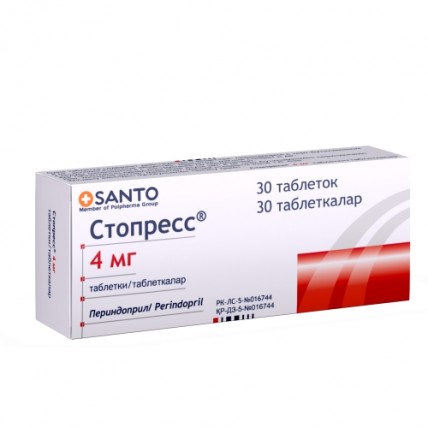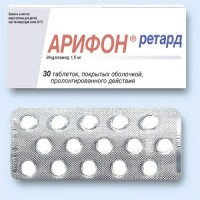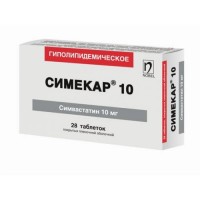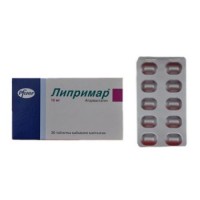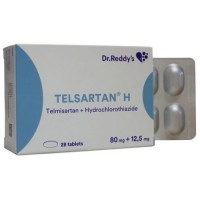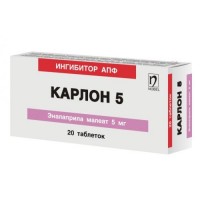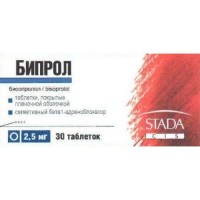Stopress 4 mg (30 tablets)
- $11.50
The trade name Stopress® the International unlicensed name Perindopril Lekarstvennaya a form of the Tablet of 4 mg and 8 mg Structure One tablet contains active agent: a perindoprila with it is grated - butylamine of 4 mg or 8 mg excipients: Mannitolum, krospovidon, magnesium stearate, butylmethacrylate copolymer the main, silicon dioxide colloidal anhydrous the Description of the Tablet of white color, oblong, biconvex, with dividing risky on both parties (for a dosage of 4 mg) Tablets of white color, round, flat (for a dosage of 8 mg) Pharmacotherapeutic group the Drugs influencing a system renin-angiotensin. Inhibitors of the angiotensin-converting enzyme (ACE). Perindopril. ATH C09A A04 code the Pharmacological Perindopril Pharmacokinetics properties is quickly soaked up, the maximum concentration is reached within 1 hour. The bioavailability is from 65 to 70%. About 20% of total amount of the adsorbed material turn in perindoprilat – an active metabolite. Besides an active perindopril five inactive metabolites are formed of a perindopril. Elimination half-life of a perindopril makes 1 hour of plasma. The maximum plasma concentration of the perindoprilat is reached within 3-4 hours. The volume of distribution of the untied perindoprilat is about 0.2 l/kg. Extent of protein-binding small (linking of the perindoprilat with angiotensin-converting enzyme makes less than 30%), but dependent on concentration. Perindoprilat is brought with urine, and elimination half-life of untied fraction makes about 3-5 hours. Dissociation of the perindoprilat connected with angiotensin-converting enzyme conducts to the effective elimination half-life equal to 25 hours, and achievement of an equilibrium state within 4 days. After repeated introduction of accumulation of a perindopril it is not observed. Removal of the perindoprilat decreases at older persons and also at patients with a heart or renal failure. It is desirable to adjust a drug dose in a renal failure depending on degree of a renal failure (clearance of creatinine). The clearance of the perindoprilat at dialysis is 70 ml/min. At patients with cirrhosis the kinetics of a perindopril changes: the hepatic clearance of an initial molecule decreases half. At the same time, the number of the formed perindoprilat does not decrease therefore dose adjustment of drug is not required. A pharmacodynamics Perindopril is an inhibitor of enzyme which turns angiotensin I into angiotensin II (angiotensin-converting enzyme, APF). The turning enzyme, or a kinase, represents an ekzopeptidaza which provides transformation of angiotensin I into a vasoconstrictor angiotensin II and also causes disintegration of a vazodilatator of bradykinin with formation of inactive heptapeptide. The inhibition of APF leads to decrease in level of angiotensin II in plasma that involves increase in activity of renin of plasma (by inhibition of negative feedback of release of renin) and decrease in secretion of Aldosteronum. As APF inactivates bradykinin, APF inhibition also leads to increase in the activity circulating and local kallikrein-kinin systems (and by that to activation of a prostaglandinovy system). It is quite possible that this mechanism promotes effect of APF inhibitors on a lowering of arterial pressure and partially explains its certain side effects (for example, cough). Action of a perindopril is caused by its active metabolite perindoprilaty. Other metabolites did not show ability to inhibit activity of APF in vitro. Hypertensia Perindopril is active at all degrees of hypertensia: easy, moderate and heavy, decrease in systolic and diastolic arterial blood pressure is noted. Perindopril reduces peripheric vascular resistance, leading to a lowering of arterial pressure. As a result there is an increase in a peripheral blood-groove without influence on heart rate. As a rule the renal blood stream whereas the glomerular filtration rate (GFR) usually does not change raises. The maximum hypotensive action is necessary for 4 to 6 hours after single administration of drug and remains for at least 24 hours: the minimum effects are 87-100% of the maximum effects. The lowering of arterial pressure occurs quickly. At the patients responding to treatment, pressure is normalized within a month and supported without development of a tachyphylaxis. Perindopril reduces a hypertrophy of a left ventricle. Perindopril shows vazodilatiruyushchy properties. He improves elasticity of arteries and reduces a ratio of a mussel - a gleam of small arteries. Auxiliary treatment by thiazide diuretics provides synergistic action of additive type. The combination of APF inhibitor and thiazide diuretic reduces risk of the hypopotassemia caused by diuretics. Heart failure of Stopress® reduces cardiac performance, reducing before - and an afterload. Researches at patients with heart failure showed: - pressure decrease of filling of the left and right ventricles - decrease in the general peripheric vascular resistance - increase in warm emission and cardiac index Indications - arterial hypertension - chronic heart failure - coronary heart disease: reduction of risk of cardiovascular complications at patients with a myocardial infarction in the anamnesis and/or a state after revascularization the Route of administration and doses Is recommended to accept Stopress® once a day in the mornings, before meal. The dose should be selected individually, taking into account a profile of the patient and dynamics of level of arterial blood pressure. Arterial hypertension of Stopress® it is possible to use in the form of monotherapy or in a combination with hypotensive drugs of other classes. The recommended initial dose makes 4 mg once a day in the morning. At patients with the significant activation system renin-angiotensin-aldosteronovoy (in particular, with renovascular hypertensia, decrease in volume of the circulating blood, a decompensation of warm activity or heavy hypertensia) after acceptance of an initial dose of drug can come sharp falling of arterial blood pressure. Recommend to such patients an initial dose of 2 mg, it is necessary to begin treatment under control of the doctor. After one month of treatment it is possible to increase a dose to 8 mg once a day. After an initiation of treatment perindoprily clinically apparent hypotension which probability is higher at patients with the accompanying treatment by diuretics can develop. To such patients recommend to take drug with caution in connection with possible decrease in volume of the circulating blood and/or deficiency of electrolytes. Whenever possible diuretics should be cancelled in 2-3 days prior to treatment perindoprily. At patients with hypertensia who cannot cancel diuretics treatment perindoprily it is necessary to begin 2 mg in a dose. It is necessary to control function of kidneys and level of potassium in blood. The subsequent doses of a perindopril should be adjusted according to the answer from arterial blood pressure. If necessary treatment by diuretics can be resumed. At elderly patients treatment it is necessary to begin with a dose 2 mg which after a month it is possible to increase to 4 mg, and then in need of and up to 8 mg, depending on function of kidneys (see the table below). Chronic heart failure of Stopress® quite often combine with prescribing of the diuretics which are not preserving potassium and/or digoxin and/or beta-blockers, in similar cases the drug should be taken under careful medical control in the recommended initial dose 2 mg in the morning. At good tolerance after not less than 2 weeks this dose can be increased by 2 mg - 4 mg once a day. Selection of a dose has to be based on the clinical answer of the specific patient. In heavy heart failure and at other patients from groups of high risk (at patients with a renal failure and a tendency to electrolytic disturbances, at the accompanying intake of diuretics and/or vazodilatator) treatment should be begun under fixed medical observation. Prior to treatment of Stopressom® at patients with high risk of developing clinically apparent hypotension (i.e. at patients with loss of electrolytes with/without hyponatremia, with a hypovolemia or at patients with the accompanying active therapy by diuretics) it is necessary to correct these states whenever possible. To and during treatment perindoprily it is necessary to control arterial blood pressure, function of kidneys and serumal level of potassium. Coronary heart disease of Stopress® it is necessary to appoint in a dose 4 mg for two weeks once a day, then to increase a dose to 8 mg once a day (depending on function of kidneys and on condition of good tolerance of a dose of 4 mg). Before increase in a dose to 8 mg once a day depending on function of kidneys the elderly patients should appoint drug on 2 mg for one week once a day, then on 4 mg for the next week, once a day (see the table 1 Dose Adjustment in a Renal Failure). The dose should be raised only in case the previous lower dose was transferred well. Dose adjustment at patients with a renal failure As it is given in table 1 below the dose at patients with a renal failure has to be based N and clearance of creatinine: Table 1: Dose adjustment at patients with a renal failure Clearance of creatinine (ml/min.) the Recommended ClCR dose ≥ 60 4 mg a day 30 & lt, ClCR & lt, 60 2 mg a day 15 & lt, ClCR & lt, 30 2 mg every other day the Patients who are on a hemodialysis *, ClCR & lt of 15 2 mg in day of performance of dialysis * Clearance of the perindoprilat at dialysis makes 70 ml/min. The patients who are on a hemodialysis have to receive this dose after the hemodialysis session. Dose adjustment with an abnormal liver function At patients with an abnormal liver function dose adjustment is not required from patients. Side effects Often (≥1/100, & lt, 1/10) - myotonia - rash, an itching - nausea, vomiting, an abdominal pain, change of taste, dyspepsia, diarrhea, a constipation - cough, short wind - arterial hypotension - a headache, dizziness, a ring in ears, a disorder of vision, paresthesias - an asthenia Infrequently (≥1/1000, & lt, 1/100) - a Quincke's disease of the face, extremities, lips, mucous membranes, language, voice folds and/or throats, a small tortoiseshell - reactions of photosensitivity, pemphigoid, a hyperhidrosis - drowsiness, a syncope - dryness in a mouth - a bronchospasm - palpitation, tachycardia - thorax pain, feeling sick, peripheral hypostases, fever - a vasculitis - increase in activity of liver enzymes and level of bilirubin in serum - increase in concentration of urea in blood, increase in concentration of creatinine in blood - disturbances of mood or a dream - a renal failure - impotence - the increased sweating - a hypoglycemia, a hyponatremia, a hyperpotassemia - an arthralgia, myalgia - accidental injuries owing to falling Is very rare (& lt, 1/10000) - confusion of consciousness - arrhythmia, stenocardia, a myocardial infarction, a stroke - eosinophilic pneumonia, rhinitis - pancreatitis, cytolytic or cholestatic hepatitis - a mnogoformny erythema - an acute renal failure - decrease in level of hemoglobin and a hematocrit, thrombocytopenia, a leukopenia/neutropenia, an agranulocytosis or a pancytopenia, hemolytic anemia (at patients with congenital insufficiency of enzyme glyukozo-6-fosfatdegidrogenazy is (G-6FDG)) Contraindications - hypersensitivity to a perindopril or auxiliary components of drug and also to other APF inhibitors - the Quincke's disease in the anamnesis connected with intake of APF inhibitors - a hereditary or idiopathic Quincke's disease - pregnancy and the period of a lactation - children's and teenage age up to 18 years the Medicinal interaction Diuretics Against the background of treatment by diuretics, especially at patients with loss of electrolytes and/or a hypovolemia, after an initiation of treatment APF inhibitor can develop an excess lowering of arterial pressure. The hypotensive effect can be reduced, due to the therapy termination by diuretics, increases in OCK or intake of salt prior to treatment by the low and gradually increasing doses of a perindopril. Kaliysberegayushchy diuretics, drugs of potassium and kaliysoderzhashchy substitutes of salt Though the serumal level of potassium usually remains within norm, at some patients against the background of treatment perindoprily the hyperpotassemia can develop. Kaliysberegayushchy diuretics (for example, Spironolactonum, Triamterenum or amiloride), can lead drugs of potassium or kaliysoderzhashchy substitutes of salt to significant increase in serumal level of potassium. For this reason the combination of a perindopril to the substances stated above is not recommended. If the accompanying use of these drugs is shown in connection with development of a hypopotassemia, it is necessary to appoint them with care, regularly controlling potassium level. Lithium drugs At the accompanying use of drugs of lithium with APF inhibitors the reversible increase in serumal concentration of lithium and its toxicity was noted. The accompanying use of thiazide diuretics can increase risk of toxicity of drugs of lithium and enhance already available risk of toxicity of lithium against the background of the accompanying intake of APF inhibitors. The combined use of a perindopril with drugs of lithium is not recommended, however in need of such combination it is necessary to carry out careful monitoring of serumal level of lithium. Non-steroidal anti-inflammatory drugs (NPVS), including aspirin in a dose of ≥3 g/days the Prescribing of non-steroidal anti-inflammatory drugs can reduce hypotensive effect of APF inhibitors. Besides, NPVS and APF inhibitors have additive effect concerning increase in serumal level of potassium and can lead to depression of function of kidneys. These effects usually have reversible character. Hypotensive drugs and vazodilatator the Accompanying use of these drugs can strengthen hypotensive action of a perindopril. Antidiabetic drugs Epidemiological researches showed that combined use of APF inhibitors and anti-diabetic drugs (insulin, oral hypoglycemic means) can cause strengthening of hypoglycemic effect with risk of development of a hypoglycemia. It was shown that this phenomenon more likely develops in time of the first weeks of the combined treatment at patients with a renal failure. Acetylsalicylic acid, trombolitik, beta-blockers, Perindopril nitrates can be appointed along with acetylsalicylic acid (when using as a trombolitik), thrombolytic means, beta-blockers and/or nitrates. Tricyclic antidepressants / antipsychotic means / anesthetics the Accompanying use with APF inhibitors of some anesthetics, tricyclic antidepressants and antipsychotic means can lead to an additional lowering of arterial pressure. Sympathomimetics Sympathomimetics can reduce hypotensive effects of APF inhibitors. Gold drugs In rare instances at the patients taking the drugs of gold and APF inhibitors, including perindoprit, face reddening, nausea, vomiting and hypotension were registered. Special instructions Stable coronary heart disease. If the episode of unstable stenocardia (expressed or not) develops in time of the first month of treatment perindoprily, before continuation of treatment it is necessary to estimate a ratio of advantage and risk carefully. Hypotension and heart failure. APF inhibitors can cause a lowering of arterial pressure. At patients the clinically apparent hypotension meets with uncomplicated hypertensia seldom, it more often meets at the patients with a hypovolemia i.e. receiving diuretics, limiting consumption of salt with food, being on a hemodialysis and also at patients with diarrhea or vomiting, or at patients with heavy renin - dependent hypertensia. At patients with clinically apparent heart failure with/without the accompanying renal failure the clinically apparent hypotension was noted. Patients with the increased risk of developing clinically apparent hypotension need careful observation at the beginning of therapy and dose adjustment. Similar requirements concern patients with coronary heart disease or a cerebrovascular disease at which the excessive lowering of arterial pressure can lead to development of a myocardial infarction or acute disorder
of cerebral circulation. At some patients with stagnant heart failure and normal or reduced arterial blood pressure the treatment perindoprily can lead to additional decrease in system arterial blood pressure. This effect is expected and usually is not the reason for the treatment termination. In case of clinically apparent hypotension the dose decline or the termination of treatment perindoprily can be required. The stenosis of the aortal and mitral valve / a hypertrophic cardiomyopathy - perindoprit it is necessary to apply with care at patients with a stenosis of the mitral valve and a stenosis of the taking-out path of a left ventricle, for example, with an aortal stenosis or a hypertrophic cardiomyopathy. The renal failure in case of a renal failure (clearance of creatinine & lt, 60 ml/min.) an initial dose of a perindopril should be adjusted according to clearance of creatinine of the patient and depending on the response of the patient to treatment. Usually, to such patients carry out control of level of potassium and creatinine in a planned order. At some patients with a bilateral renal artery stenosis or a stenosis of an artery of the only kidney which received treatment by APF inhibitors, increase in level of urea of blood and creatinine of serum which usually had reversible character after the treatment termination was noted. It is especially probable at patients with a renal failure. In case of renovascular hypertensia there is an increased risk of heavy hypotension and renal failure. At such patients the treatment should be begun under careful medical control with low doses with the subsequent careful selection of a dose. As treatment by diuretics can be the promoting factor of development of the phenomena described above, in the first weeks of treatment perindoprily diuretics should be cancelled, controlling at the same time function of kidneys. Hemodialysis / LPNP-lipidny-aferez / Therapy for desensitization At co-administration of a perindopril and dialysis about polyacrylic - a nitrile membrane or LDL (lipoprotein of low density) - an afereza by means of sulfate of a dextran or desensitization against poisons of insects (bees, wasps) the development of an acute anaphylaxis is possible. It is recommended to use other membrane for dialysis or it is necessary to replace temporarily perindoprit other antihypertensive drugs (not APF inhibitors). Before performing desensitization it is necessary to cancel perindoprit. Transplantation of a kidney Is not present experience of use of drug for patients which carried out transplantation of a kidney recently. Hypersensitivity / a Quincke's disease Occasionally at the patients receiving treatment by APF inhibitors, including perindoprit, the Quincke's disease of the face, extremities, lips, mucous membranes, language, voice folds and/or throats can develop. This phenomenon can develop at any time in treatment time. In similar cases treatment perindoprily it is necessary to stop and begin immediately the corresponding monitoring of a state which is continued to full permission of symptoms. When hypostasis was limited to limits of the face and lips, the phenomenon was usually allowed without treatment though for relief of symptoms used antihistamines. The Quincke's disease in combination with a laryngeal edema can lead to death. In case of a paraglossa, voice folds and a throat with a high probability of obstruction of airways it is necessary to appoint emergency treatment immediately. It can include administration of adrenaline and/or maintenance of passability of airways. The patient has to be under fixed medical control to full and resistant permission of symptomatology. Anaphylactoid reactions of an aferez of lipoproteids of the low density (LDL) In rare instances at the patients accepting APF inhibitors in time of an aferez of lipoproteids of the low density (LDL) about a dextran sulfate developed in time life-threatening anaphylactoid reactions. These reactions manage to be avoided, temporarily stopping treatment by APF inhibitor before each aferez. The liver failure In rare instances treatment by APF inhibitors is followed by a syndrome which begins with cholestatic jaundice and progresses with development of fulminantny necrosis of a liver, and sometimes and death. The mechanism of development of this syndrome is unknown. If against the background of treatment by APF inhibitors jaundice or significant increase in level of enzymes of a liver develop, APF inhibitor it is necessary to cancel and appoint the corresponding medical subsequent observation. Neutropenia/agranulocytosis/thrombocytopenia/anemia At the patients receiving APF inhibitors the development of a neutropenia/agranulocytosis, thrombocytopenia and anemia is noted. At patients with normal function of kidneys and without the other complicating factors the neutropenia develops seldom. Perindopril it is necessary to use extremely carefully at patients with collagenoses, against the background of immunnodepressantny therapy, treatment by Allopyrinolum or procaineamide, or at a combination of these complicating factors, especially in case of the previous renal failure. At some of these patients serious infections which in some cases do not respond to active antibacterial therapy develop. When assigning the periodic monitoring of level of leukocytes is recommended to such patients of a perindopril. Patsiyentov it is necessary to instruct to report about any symptoms of an infection. Surgery/anesthesia during large surgery or during anesthesia with use of drugs which lead to development of hypotension perindoprit can block formation of angiotensin II owing to compensatory release of renin. Treatment should be stopped a day before operation. At development of the hypotension connected with this mechanism it can be adjusted by means of infusional therapy. A hyperpotassemia At some patients against the background of treatment by APF inhibitors, including perindoprit, increase in serumal level of potassium was noted. Patients with a renal failure, uncontrollable diabetes, the persons receiving kaliysberegayushchy diuretics, drugs of potassium or kaliysoderzhashchy substitutes of salt and also the other drugs leading to increase in serumal level of potassium treat patients with risk of development of a hyperpotassemia (for example, heparin). In need of the accompanying intake of the drugs stated above the regular monitoring of serumal level of potassium is recommended. Patients with diabetes At the patients with diabetes receiving oral anti-diabetic drugs or insulin for the first month of treatment by APF inhibitor it is necessary to control glycemia level fixedly. Cough Cough when prescribing APF inhibitors is unproductive, resistant and passes after the therapy termination. Use in pediatrics the Efficiency and safety of use of a perindopril for children are not established. For this reason the use of drug for children up to 18 years is not recommended. The feature of influence on ability to run the vehicle or potentially dangerous mechanisms When driving or potentially dangerous mechanisms should consider that at administration of drug there can sometimes be dizziness or weakness. Overdose Symptoms: hypotension, shock, electrolytic disturbances, renal failure, hyperventilation of lungs, tachycardia, heartbeat, bradycardia, dizziness, concern and cough. Treatment: intravenous administration of normal saline solution. At development of hypotension of the patient it is necessary to place in a dorsal decubitus with the raised legs. If necessary introduction of infusions of angiotensin II and/or intravenous administration of catecholamines, atropine. Hemodialysis. At development of the bradycardia permanent to conservative therapy, setting of a pacemaker is shown. It is necessary to control continuously indicators of the vital functions, serumal level of electrolytes and creatinine. A form of release and packing On 10 tablets in blister strip packaging (blister) from ACLAR/PVC/Al film. On 3 planimetric packs together with the approved instruction for medical use in the state and Russian languages put in a cardboard pack. To Store storage conditions in the dry, protected from light place, at a temperature not over 25C. To store out of children's reach. 3 years not to use a period of storage after expiry date. Prescription status According to the prescription the Producer the Pharmaceutical plant JSC Polfarm, Poland of st. of Pelplinsk 19, 83-200 Starogard Gdanski the Owner of the registration certificate of JSC Khimfarm, the Republic of Kazakhstan the Address of the organization accepting in the territory of the Republic of Kazakhstan claims from consumers on quality of products (goods) of JSC Khimfarm, Shymkent, Republic of Kazakhstan, Rashidov St., 81 Phone number 7252 (561342) Fax number 7252 (561342)
to Develop
of cerebral circulation. At some patients with stagnant heart failure and normal or reduced arterial blood pressure the treatment perindoprily can lead to additional decrease in system arterial blood pressure. This effect is expected and usually is not the reason for the treatment termination. In case of clinically apparent hypotension the dose decline or the termination of treatment perindoprily can be required. The stenosis of the aortal and mitral valve / a hypertrophic cardiomyopathy - perindoprit it is necessary to apply with care at patients with a stenosis of the mitral valve and a stenosis of the taking-out path of a left ventricle, for example, with an aortal stenosis or a hypertrophic cardiomyopathy. The renal failure in case of a renal failure (clearance of creatinine & lt, 60 ml/min.) an initial dose of a perindopril should be adjusted according to clearance of creatinine of the patient and depending on the response of the patient to treatment. Usually, to such patients carry out control of level of potassium and creatinine in a planned order. At some patients with a bilateral renal artery stenosis or a stenosis of an artery of the only kidney which received treatment by APF inhibitors, increase in level of urea of blood and creatinine of serum which usually had reversible character after the treatment termination was noted. It is especially probable at patients with a renal failure. In case of renovascular hypertensia there is an increased risk of heavy hypotension and renal failure. At such patients the treatment should be begun under careful medical control with low doses with the subsequent careful selection of a dose. As treatment by diuretics can be the promoting factor of development of the phenomena described above, in the first weeks of treatment perindoprily diuretics should be cancelled, controlling at the same time function of kidneys. Hemodialysis / LPNP-lipidny-aferez / Therapy for desensitization At co-administration of a perindopril and dialysis about polyacrylic - a nitrile membrane or LDL (lipoprotein of low density) - an afereza by means of sulfate of a dextran or desensitization against poisons of insects (bees, wasps) the development of an acute anaphylaxis is possible. It is recommended to use other membrane for dialysis or it is necessary to replace temporarily perindoprit other antihypertensive drugs (not APF inhibitors). Before performing desensitization it is necessary to cancel perindoprit. Transplantation of a kidney Is not present experience of use of drug for patients which carried out transplantation of a kidney recently. Hypersensitivity / a Quincke's disease Occasionally at the patients receiving treatment by APF inhibitors, including perindoprit, the Quincke's disease of the face, extremities, lips, mucous membranes, language, voice folds and/or throats can develop. This phenomenon can develop at any time in treatment time. In similar cases treatment perindoprily it is necessary to stop and begin immediately the corresponding monitoring of a state which is continued to full permission of symptoms. When hypostasis was limited to limits of the face and lips, the phenomenon was usually allowed without treatment though for relief of symptoms used antihistamines. The Quincke's disease in combination with a laryngeal edema can lead to death. In case of a paraglossa, voice folds and a throat with a high probability of obstruction of airways it is necessary to appoint emergency treatment immediately. It can include administration of adrenaline and/or maintenance of passability of airways. The patient has to be under fixed medical control to full and resistant permission of symptomatology. Anaphylactoid reactions of an aferez of lipoproteids of the low density (LDL) In rare instances at the patients accepting APF inhibitors in time of an aferez of lipoproteids of the low density (LDL) about a dextran sulfate developed in time life-threatening anaphylactoid reactions. These reactions manage to be avoided, temporarily stopping treatment by APF inhibitor before each aferez. The liver failure In rare instances treatment by APF inhibitors is followed by a syndrome which begins with cholestatic jaundice and progresses with development of fulminantny necrosis of a liver, and sometimes and death. The mechanism of development of this syndrome is unknown. If against the background of treatment by APF inhibitors jaundice or significant increase in level of enzymes of a liver develop, APF inhibitor it is necessary to cancel and appoint the corresponding medical subsequent observation. Neutropenia/agranulocytosis/thrombocytopenia/anemia At the patients receiving APF inhibitors the development of a neutropenia/agranulocytosis, thrombocytopenia and anemia is noted. At patients with normal function of kidneys and without the other complicating factors the neutropenia develops seldom. Perindopril it is necessary to use extremely carefully at patients with collagenoses, against the background of immunnodepressantny therapy, treatment by Allopyrinolum or procaineamide, or at a combination of these complicating factors, especially in case of the previous renal failure. At some of these patients serious infections which in some cases do not respond to active antibacterial therapy develop. When assigning the periodic monitoring of level of leukocytes is recommended to such patients of a perindopril. Patsiyentov it is necessary to instruct to report about any symptoms of an infection. Surgery/anesthesia during large surgery or during anesthesia with use of drugs which lead to development of hypotension perindoprit can block formation of angiotensin II owing to compensatory release of renin. Treatment should be stopped a day before operation. At development of the hypotension connected with this mechanism it can be adjusted by means of infusional therapy. A hyperpotassemia At some patients against the background of treatment by APF inhibitors, including perindoprit, increase in serumal level of potassium was noted. Patients with a renal failure, uncontrollable diabetes, the persons receiving kaliysberegayushchy diuretics, drugs of potassium or kaliysoderzhashchy substitutes of salt and also the other drugs leading to increase in serumal level of potassium treat patients with risk of development of a hyperpotassemia (for example, heparin). In need of the accompanying intake of the drugs stated above the regular monitoring of serumal level of potassium is recommended. Patients with diabetes At the patients with diabetes receiving oral anti-diabetic drugs or insulin for the first month of treatment by APF inhibitor it is necessary to control glycemia level fixedly. Cough Cough when prescribing APF inhibitors is unproductive, resistant and passes after the therapy termination. Use in pediatrics the Efficiency and safety of use of a perindopril for children are not established. For this reason the use of drug for children up to 18 years is not recommended. The feature of influence on ability to run the vehicle or potentially dangerous mechanisms When driving or potentially dangerous mechanisms should consider that at administration of drug there can sometimes be dizziness or weakness. Overdose Symptoms: hypotension, shock, electrolytic disturbances, renal failure, hyperventilation of lungs, tachycardia, heartbeat, bradycardia, dizziness, concern and cough. Treatment: intravenous administration of normal saline solution. At development of hypotension of the patient it is necessary to place in a dorsal decubitus with the raised legs. If necessary introduction of infusions of angiotensin II and/or intravenous administration of catecholamines, atropine. Hemodialysis. At development of the bradycardia permanent to conservative therapy, setting of a pacemaker is shown. It is necessary to control continuously indicators of the vital functions, serumal level of electrolytes and creatinine. A form of release and packing On 10 tablets in blister strip packaging (blister) from ACLAR/PVC/Al film. On 3 planimetric packs together with the approved instruction for medical use in the state and Russian languages put in a cardboard pack. To Store storage conditions in the dry, protected from light place, at a temperature not over 25C. To store out of children's reach. 3 years not to use a period of storage after expiry date. Prescription status According to the prescription the Producer the Pharmaceutical plant JSC Polfarm, Poland of st. of Pelplinsk 19, 83-200 Starogard Gdanski the Owner of the registration certificate of JSC Khimfarm, the Republic of Kazakhstan the Address of the organization accepting in the territory of the Republic of Kazakhstan claims from consumers on quality of products (goods) of JSC Khimfarm, Shymkent, Republic of Kazakhstan, Rashidov St., 81 Phone number 7252 (561342) Fax number 7252 (561342)
to Develop
